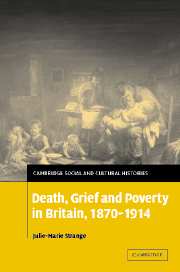Book contents
- Frontmatter
- Contents
- Acknowledgements
- List of abbreviations
- 1 Introduction: revisiting the Victorian and Edwardian celebration of death
- 2 Life, sickness and death
- 3 Caring for the corpse
- 4 The funeral
- 5 Only a pauper whom nobody owns: reassessing the pauper burial
- 6 Remembering the dead: the cemetery as a landscape for grief
- 7 Loss, memory and the management of feeling
- 8 Grieving for dead children
- 9 Epilogue: death, grief and the Great War
- Bibliography
- Index
6 - Remembering the dead: the cemetery as a landscape for grief
Published online by Cambridge University Press: 05 July 2009
- Frontmatter
- Contents
- Acknowledgements
- List of abbreviations
- 1 Introduction: revisiting the Victorian and Edwardian celebration of death
- 2 Life, sickness and death
- 3 Caring for the corpse
- 4 The funeral
- 5 Only a pauper whom nobody owns: reassessing the pauper burial
- 6 Remembering the dead: the cemetery as a landscape for grief
- 7 Loss, memory and the management of feeling
- 8 Grieving for dead children
- 9 Epilogue: death, grief and the Great War
- Bibliography
- Index
Summary
Lowering the dead into the grave represented the climax of the funeral, whilst sprinkling soil onto the coffin lid signified the finality of death and, crucially, burial rites. The subsequent installation of a memorial provided the bereaved with a point of commemoration to which they could repeatedly return. The headstone narrated a biography of the deceased, enabled relatives to reconstruct the family unit in stone and represented a metaphor for loss. This chapter reads burial space as a landscape for the expression of grief and explores the tensions inherent in the appropriation of public space for the articulation of private identity, loss and memory. It also considers ideals relating to the sanctity of burial space, especially in the supposedly secular context of the municipal cemetery. Departing from the romanticism of private enterprise garden cemeteries established at the beginning of the century, the creation of municipal grounds in the latter half of the nineteenth century combined utility and hygiene with commerce. Despite the functional ethos guiding most municipal endeavours, however, cemeteries continued to be shaped by an impulse to civilise, educate and uplift the common visitor. In the secular cemetery, still colloquially known as ‘God's acre’, sacrosanct ideals of the grave resonated with shared understandings of dignity in death and the ability to articulate the ownership and identity of the corpse. In this sense, the significance attached to the consecration or denominational affiliation of the ground was often inextricable from the importance invested in secular rights of interment.
- Type
- Chapter
- Information
- Death, Grief and Poverty in Britain, 1870–1914 , pp. 163 - 193Publisher: Cambridge University PressPrint publication year: 2005
- 1
- Cited by



